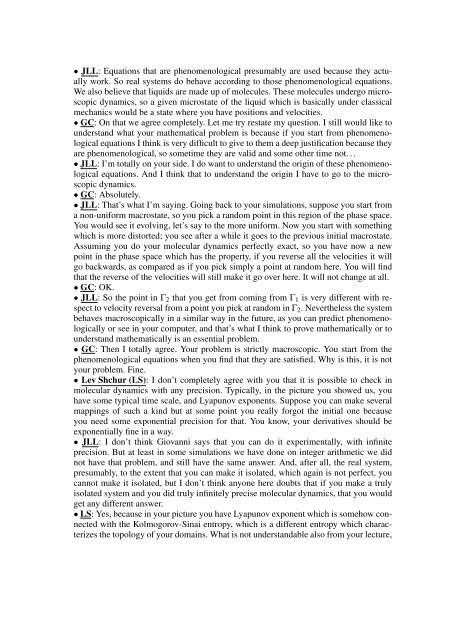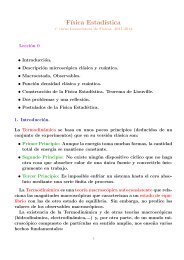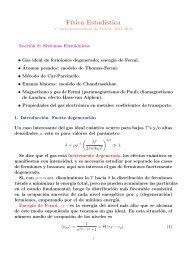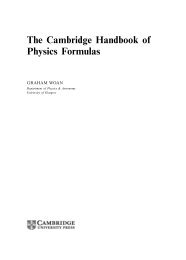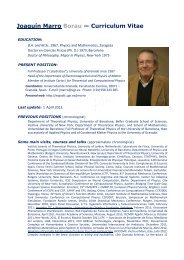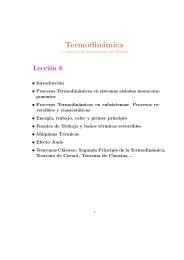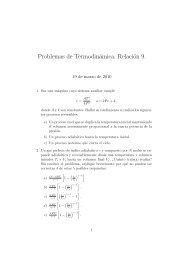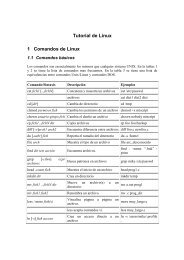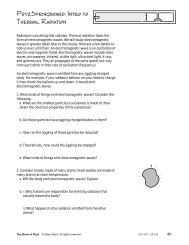23966k - Instituto Carlos I - Universidad de Granada
23966k - Instituto Carlos I - Universidad de Granada
23966k - Instituto Carlos I - Universidad de Granada
Create successful ePaper yourself
Turn your PDF publications into a flip-book with our unique Google optimized e-Paper software.
• JLL: Equations that are phenomenological presumably are used because they actually<br />
work. So real systems do behave according to those phenomenological equations.<br />
We also believe that liquids are ma<strong>de</strong> up of molecules. These molecules un<strong>de</strong>rgo microscopic<br />
dynamics, so a given microstate of the liquid which is basically un<strong>de</strong>r classical<br />
mechanics would be a state where you have positions and velocities.<br />
• GC: On that we agree completely. Let me try restate my question. I still would like to<br />
un<strong>de</strong>rstand what your mathematical problem is because if you start from phenomenological<br />
equations I think is very difficult to give to them a <strong>de</strong>ep justification because they<br />
are phenomenological, so sometime they are valid and some other time not. . .<br />
• JLL: I’m totally on your si<strong>de</strong>. I do want to un<strong>de</strong>rstand the origin of these phenomenological<br />
equations. And I think that to un<strong>de</strong>rstand the origin I have to go to the microscopic<br />
dynamics.<br />
• GC: Absolutely.<br />
• JLL: That’s what I’m saying. Going back to your simulations, suppose you start from<br />
a non-uniform macrostate, so you pick a random point in this region of the phase space.<br />
You would see it evolving, let’s say to the more uniform. Now you start with something<br />
which is more distorted; you see after a while it goes to the previous initial macrostate.<br />
Assuming you do your molecular dynamics perfectly exact, so you have now a new<br />
point in the phase space which has the property, if you reverse all the velocities it will<br />
go backwards, as compared as if you pick simply a point at random here. You will find<br />
that the reverse of the velocities will still make it go over here. It will not change at all.<br />
• GC: OK.<br />
• JLL: So the point in Γ2 that you get from coming from Γ1 is very different with respect<br />
to velocity reversal from a point you pick at random in Γ2. Nevertheless the system<br />
behaves macroscopically in a similar way in the future, as you can predict phenomenologically<br />
or see in your computer, and that’s what I think to prove mathematically or to<br />
un<strong>de</strong>rstand mathematically is an essential problem.<br />
• GC: Then I totally agree. Your problem is strictly macroscopic. You start from the<br />
phenomenological equations when you find that they are satisfied. Why is this, it is not<br />
your problem. Fine.<br />
• Lev Shchur (LS): I don’t completely agree with you that it is possible to check in<br />
molecular dynamics with any precision. Typically, in the picture you showed us, you<br />
have some typical time scale, and Lyapunov exponents. Suppose you can make several<br />
mappings of such a kind but at some point you really forgot the initial one because<br />
you need some exponential precision for that. You know, your <strong>de</strong>rivatives should be<br />
exponentially fine in a way.<br />
• JLL: I don’t think Giovanni says that you can do it experimentally, with infinite<br />
precision. But at least in some simulations we have done on integer arithmetic we did<br />
not have that problem, and still have the same answer. And, after all, the real system,<br />
presumably, to the extent that you can make it isolated, which again is not perfect, you<br />
cannot make it isolated, but I don’t think anyone here doubts that if you make a truly<br />
isolated system and you did truly infinitely precise molecular dynamics, that you would<br />
get any different answer.<br />
• LS: Yes, because in your picture you have Lyapunov exponent which is somehow connected<br />
with the Kolmogorov-Sinai entropy, which is a different entropy which characterizes<br />
the topology of your domains. What is not un<strong>de</strong>rstandable also from your lecture,


